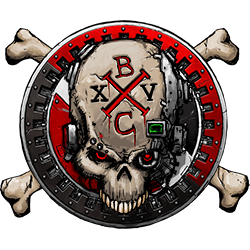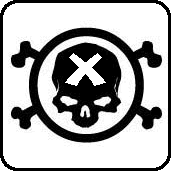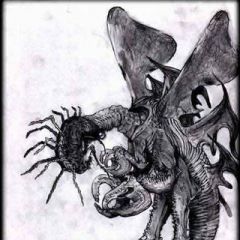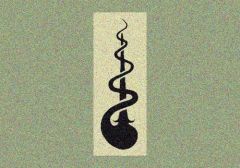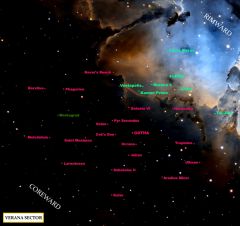-
Posts
64 -
Joined
-
Last visited
About Jape

Profile Information
-
Location
Liverpool Hive
-
Interests
Writing, History, Comedy, Weird Fiction
Previous Fields
-
Armies played
Imperial Guard, Space Marines, Tyranids, Orks, Chaos Space Marines
Jape's Achievements
-
Murat http://ichef.bbci.co.uk/naturelibrary/images/ic/credit/640x395/s/sw/swamp/swamp_1.jpg Belater’s second moon and certainly the smallest, Murat is for lack of a better term a swamp world. Steaming bogs and teeming marshes are dotted by islands of dry land, many home to valuable veins of adamantium. Mining these sites led to tentative colonisation. Disease, violent wildlife and the extreme lack of arable land all hampered settlement and by extension export. This was not helped by discovery of several feral Gretchin tribes living the deepest depths of the swamps. Possibly unintentional colonists during the system’s pre-history (Imperial colonisation having only taken place in the late 38th millennium), they quickly presented an unexpected challenge to the human settlers. Poorly armed miners established stockades around their villages, night time raids by Gretchins using sheer numbers became a common occurrence and more than one Imperial settlement fell to these tactics. Deemed at worst a pathetic distraction rather than a true threat, then Grand Prince Jan Lupolt ordered a regiment of Gendarmes to Murat to crush the xenos. However their numbers and knowledge of the environment saw the ‘Grot hunt’ turn into months of low-level guerilla warfare as the Gendarmes’ commitment grew to little apparent effect. The august House of Koba-Faraad, a powerful rogue trader dynasty in the Sector and major investors in the adamantium mines sent several companies of their ruthless chem-soldiers, the Sipahi to end the conflict however they too could only partially wipe out the xenos. At one point, perhaps overestimating his galactic stature, Jan Lupolt contacted the Deathwatch requesting aid. The Ordo Xenos response was a baffled refusal. Eventually after several years the last Gretchin tribes were crushed. The Grand Prince had the head of the last alien kings, Topgrot Olfang put on display in Verdan. The Grot War is remembered as a tragicomic farce and amongst Gendarmes and Fusiliers alike it is never mentioned. Hatred for the memory famously led to blood during the Second Canopus campaign in 886.M41, when a captain of the Pyran Dragoons mocked a Belateran counterpart, Captain Lix Gelfon, calling up the war. Gelfon slapped the unknown Pyran officer and demanded a duel, shooting his besmircher straight through the heart. By far more deadly, at least entity for entity, are the mysterious Loky. Chameleonic, and notable psykers they ‘feed’ on human beings, draining their psychic energy. Very little is known about them though it is assumed they are native to Murat. Their intelligence is disputed. While mentally powerful they are seemingly simple predators; there has been no sign of technology or settlement. However the skills of their ambushes suggest more than a base pack mentality. The miners stick closely to their fortified villages, particularly at night. However most of the population are at least familiar with a gun, usually simple blackpowder weapons used for hunting. Autogun militias do exist but are poorly trained and motivated, many taking their annual term of service as an excuse to leave the pits and relax in the local bar. The other major Imperial population on Murat is abhuman. Grand Prince Favron III granted refuge to the remnants of a Ratling colony terrorised by Dark Eldar in 999.M40. Done entirely to provide fresh colonists for the unwelcoming moon, after serious losses in the early years to Murat’s environment, the Ratling thrived to some extent. Several communities exist, often far from human habitation. The Ratlings’ skills as farmers and merchants make them a valued if somewhat discriminated part of Murat society, known as the demi-mon. Some humans live alongside them, often trappers and hunters operating on the outskirts of what little civilisation the moon can claim to hold. Most settlements and villages operate virtually autonomously save for adamantium exports. Governance is limited to Koba-Faraad inspectors and the Gendarme garrison at Fort Jan Lupolt. A crude stone and mud bastion, the surrounding settlement forms Murat’s only true town of around 10,000 citizens, most employed directly by the mining cartel. Due to their economic value, the miner and bureaucrat majority are rarely drafted for the Fusiliers. Instead it is the demi-mon that provide Murat’s only notable contribution to the Imperial Guard. Demi-mon snipers are a powerful contribution to Belateran campaigns dominated by urban and trench warfare. Where possible Fusilier regiments will often have several platoons of Ratlings embedded in their command structure.
- 3 replies
-
- astra militarum
- imperial guard
-
(and 1 more)
Tagged with:
-
Yes understood.
-
 WG101 reacted to a post in a topic:
THE LIBER CLUSTER II
WG101 reacted to a post in a topic:
THE LIBER CLUSTER II
-
 Machine God reacted to a post in a topic:
THE LIBER CLUSTER II
Machine God reacted to a post in a topic:
THE LIBER CLUSTER II
-
Oathkeepers http://www.bolterandchainsword.com/sm.php?b62c=@hFZ83_iakk7.hIAEG@@@@_._h81dX.hozqS@@i8khi_@@@@@@@@@@@._._@@@_.@@@_.hozqShozqS@@@_._@@.@@@@hozqSh81dX&grid=TRUE Chapter Icon idea Gene Seed: Salamanders Founding: Ultima Chapter Master: Yohannes Afriki Strength: ~800 Base of Operations: Salas Observed Strategic Tendencies: Rapid Response, Defence Battlecry: Through Fire and Fury Name It is believed the chapter’s name was given by the Salamanders’ chapter-master Tu’Shan. During the Heliox Campaign, as battered Imperial forces retreated across the River Schlek, then Captain Yohannes Afriki led eighty Unnumbered Sons to hold Bridge 226 against hordes of Khorne fanatics to cover the withdrawal. After five days and half their number dead and many others wounded, Guard and Salamander forces relieved them pushing back across the river. Tu’Shan commended their Captain for his tactical skill and doggedness, Afriki having lost an arm in the fighting yet continued to lead the defence. When asked by the leader of his progenitors how he had held against such great odds, Afriki humbly replied, “We swore to hold the bridge and so we did”. Tu’Shan dubbed him Oathkeeper, the honour no doubt crucial in Afriki being given command of his own chapter. World The Oathkeepers were one of many chapters founded from veterans of the Unnumbered Sons. In the aftermath of the Indomitus Crusade they were sent to the Liber Cluster and given the world of Salas to make their home. An oceanic world dotted by numerous archipelagos, its primitive island nations battle continuously on land and sea. These wars are powered by slaves, whether as oarsmen of the great galleys or as the elite soldiers of Salasi kings, raised from birth to fight, known commonly as amari. The dominance of slavery in nearly all sections of Salasi society and culture has created serious tensions between the natives and their new overlords. Chapter-Master Yohannes Afriki had been blooded battling Dark Eldar slavers in the Pnoxus Sector and held a deep loathing of the practice, seeing it as xeno and beneath humanity. Many of his battle-brothers concurred but efforts to curb the practice soon presented problems. On the Isle of Xoth, the amari on being declared free committed suicide en masse, their king gloating bitterly to Afriki that his “sons” had pledged only to leave him in death. Other slave populations proved less submissive and news that the sky-giants intended to remove their chains quickly spread, triggering riot and revolution across the globe. Perhaps not truly grasping the power of the Astartes, dozens of island states formed an alliance to resist abolition. Tiring of diplomacy, Afriki led his First Company to make an example of Faraad, the largest and by far wealthiest of Salas’ island kingdoms, her slave markets unparalleled. Descending from the sky the Oathkeepers slaughtered thousands. While the citizen militias were brushed aside, the amari defended their king’s palace to the last, many armed with ancient autoguns. The Sack of Faraad caused many islands to submit but even now there was word of slave-armies readying themselves to resist. Afriki knew well he could scourge the entire planet with a fraction of his forces, however he had no wish to rule by terror, while the needs of recruitment and the Oathkeepers’ duties beyond Salas meant he needed to resolve the issue quickly. Gathering the major kings and consuls, Afriki proclaimed slavery could remain but the slave trade was ended and thousands who had risen up were to be given lands of their own. The Oathkeepers would have first pick of young amari recruits and collect a ‘tithe’ of 10% of each kingdom’s slave population once a generation to become serfs and workers at the chapter’s new headquarters on the Zul-Bha-Shir archipelago, or simply transported to the “free kingdoms”. This would prove the main source of recruitment for the sicari, the new planetary defence forces. The Salasi submitted but to this day Oathkeeper and sicari patrols discover slavers operating on the open oceans, their captains being returned to their home cities to be executed and their bodies displayed in public squares. _____ Will add more regarding the Oathkeepers regarding tactics, notable members etc. just wanted to type this up. Quite like the idea of a homeworld whose population aren't actually that keen on their ubermensch overlords and the 'newness' of the Ultima Founding offers plenty of room for growing pains.
-
 walter h reacted to a post in a topic:
113th Belaterian Fusiliers (WIP)
walter h reacted to a post in a topic:
113th Belaterian Fusiliers (WIP)
-
Whoops, I meant a Bane Wolf variant. Thank you very much Bjorn. I hadn't really thought about the load-out of them though krak missiles could be common to provide on the spot anti-tank assistance
- 3 replies
-
- astra militarum
- imperial guard
-
(and 1 more)
Tagged with:
-
 Bjorn Firewalker reacted to a post in a topic:
113th Belaterian Fusiliers (WIP)
Bjorn Firewalker reacted to a post in a topic:
113th Belaterian Fusiliers (WIP)
-
Belater Segmentum: Ultima Sector: Verana Sub-Sector: Cob System: Belatera Population: 4.28 billion Tithe: Exactis Particular Class: Industrial World Belater is an industrial world located within the Verana Sector. Its 4 billion inhabitants slave away in gargantuan factories supplying war materials to the wider sector and beyond. Crowded slums dominate the cities, their weary inhabitants turning to alco-synth and illicit entertainments for distraction. The elite live within sheltered spires. In Verdan, the planetary capital, these towers rise up in the centre of the city, together with cathedrals and the great, almost pyramidal, Ministry buildings. This gleaming city within a city stretches high into the sky, looming over the untold millions beneath. There are seven major cities dotted across Belater containing over 90% of the population. Much of the rest of the planet is arid wilderness owing to intense pollution. These deserts are amazingly still home to various nomadic tribes and warbands who scavenge and raid to survive. Many amongst their number are what is classified as “asocial” by the government; mutants, heretics, dissidents and criminals fleeing from the authoritarian rule of urban society. Frontier settlements, usually established to mine and drill for resources, are regular targets for these renegades and bandits. The government of Belater is ostensibly democratic. A parliament known as the Chamber is elected by the upper-classes to oversee the planet, however power truly lies with the Central Council. A cabinet chosen by the Chamber, in reality it is controlled by the military and bureaucracy. At its head the Imperial governor, or Premier-General, has been a high ranking officer since the title’s creation, the Chamber little more than a rubber-stamp to their commands. Regardless they are not untouchable. Palace coups, assassinations and even proletarian riots have been known to end a Premier-General’s term in office prematurely. As such a streak of populism is always a desirable quality in Belaterian politics. Bread and circuses are regularly lavished on the Verdan ‘mob’ in the form of extra rations and blood sports. At the same time a totalitarian state keeps a close eye on the populace. While ‘lesser’ criminal enterprises are often overlooked or indeed quietly endorsed by those at the top, an unguarded comment in the ration queue or a dissenting opinion told in confidence will often lead to a visit from agents of the Special Directorate. Those “taken for questioning” are rarely seen again. The planet’s particular system of government stems from the Belaterian Civil War. Then a hereditary monarchy, the ruling nobility had fled from the planet centuries earlier to escape its inhospitable climate, settling on Belater’s largest moon Floriana. A lush, agricultural world supplying Belater with the majority of its food, soon grand estates and palaces were constructed to house the lords, first amongst them the Grand Prince of the House Vyon. By 421.M40 this title was held by Alfons XIV. Remembered by the (admittedly biased) history books as a dull-minded, corpulent figure, he ultimately was little different from a succession of absentee princes, more interested in feasts and games than in running a planet of billions. Regardless Alfons was in no doubt as to his Throne-given right to rule without question. In that momentous year, poor harvests on Floriana has led already meagre rations on Belater to be reduced further. As the people stewed, rumour spread that Alfons had halted a food shipment destined for their world to supply a lavish summer banquet. It proved the spark needed to inflame the downtrodden population into open revolution. As entire cities rose up, the Grand Prince ordered the planetary defence forces, the Gendarme, to shoot the rioters in Verdan. Most gendarmes were lower-class conscripts, poorly paid and disgruntled themselves. In the moment they refused to fire on their fellow proles. General uprising combined with military mutiny confirmed in the minds of various younger officers of the need to lead the public tide or be consumed by it. Led by Brigadier Fernand Torayne, the cabal overthrew their superiors in Verdan and declared the army for the people. This didn’t prove entirely true. The cities of Ximes and Brennus in the south declared for the Grand Prince, while elsewhere Gendarme units and the greater population turned on themselves, divided by civil war. The scattered mining communities of Murat, Belater’s second moon, fell to the cabal without a shot, the commandant a trusted acolyte of Torayne. Revolution even briefly spread to Floriana with peasants storming the palaces of the nobility before being crushed by the Grand Prince’s Household Guard. Torayne knew that the seizure of Floriana was critical. Without imports from the garden moon Belater would starve. As royalist forces marched north towards Verdan, the General led a motley armada of sub-warp transports carrying six regiments towards Alfons’ domain. Though the pastoral world had only limited defences, the derelict invasion fleet still suffered serious losses as the rebels struggled to establish a bridgehead. Slowly but surely they pushed the Household Guard back to the Vyon Palace. Though appearing to be simply a grandiose baroque mansion, the Palace was a veritable fortress. The rebels paid dearly in assault after assault on the hidden pillboxes, minefields and kill zones of the picturesque estate. After weeks of brutal siege warfare, Torayne’s gendarmes finally broke into the palace interior and overwhelmed the defenders. Alongside many of his inner circle Grand Prince Alfons XIV had committed suicide rather than face the ‘mob’. Hopes this would end the Civil War proved misguided. In Torayne’s absence the citizen militias of Verdan and neighbouring rebel cities had paid a high price to hold the royalist forces along the Majanon Front. A chill lifeless moor, the region had become a warren of trenches as the two sides attempted to grind each other down. The death of the grand prince and capture of the Floriana breadbasket saw several contested cities like Mon-Saint and Jacoban finally succumb to the rebels. However the core royalist cities of Ximes and Brennus remained, with Alfons’ imbecilic nephew being declared Leo XXI in 423.M40. The war dragged on for several years, the ‘rebels’ unable to penetrate the southern royalist fortifications. In 426.M40 Ottokar Vesp, an industrial chemist drafted into the war effort, developed a deadly toxin known as vespene gas. It was quickly weaponised to brutal effect. The Brigadier’s superiority in weapons, men and industry was made plain during the summer operations of the following year. The horrors of vespene were made clear to royalist troops as vast artillery bombardments of shells filled with poison gas rained down upon them. Corrosive, asphyxiating and yet quick to disperse, rebel tanks and soldiers often advanced unopposed for miles past the blistered and contorted remains of their enemies. The gas was also employed in terror bombings against royalist cities and towns. The bodies of the dead piled in the streets, so much so that entire units had to be reassigned solely to the disposal of corpses. Within four months the royalists collapsed, the Vespene Offensive having claimed millions of lives. Brigadier Torayne was now the undisputed ruler of Belater. The Brigadier’s military cabal, wary not only of royalist sympathisers but the radicalism of the lower-classes, made alliance with the only force on Belater that could appeal to and suffocate both, the Church. Members of the Ministorum had been divided by the conflict just like the rest of the planet though royalism had certainly dominated. The Planetary Pontifex had even died with the Exalted Blade of St. Rufon in hand during the last stand at Ximes. Opportunism and genuine fear of the masses saw monarchist pretensions quickly disappear amongst the Belaterian clergy. The two established an authoritarian regime, with supposed royalist agents and radical revolutionaries being burned in public squares alongside heretics and mutants, as secret police infiltrated every section of society. The velvet glove to this iron fist came in the form of grand spectacle. Holy festivals, military parades and the re-opening of the combat arenas, suppressed by Alfons’ great-grandfather Filup the Dour. It took centuries for the planet to truly recover from the destruction of the civil war. The city of Brennus, its cathedral-factories once the engine of the royalist war effort, remains a half abandoned ruin, a shell of its Vyon-era glory. However the conflict had unexpected boons, at least for the new ruling elite. The demands of war and mass mobilisation of the population had expanded Belaterian industry only further. The Gendarmes had conscripted much of the adult population whether as front line troops or regimented labour in factories and mines. This continued in peace with all able bodied men and women serving for five years. Though often restricted to garrison duty and labour projects, the planetary defence forces have been blooded countless times fighting desert raiders, the chameleonic xenos of Murat and occasionally rioting proles. However unlike the discontented draftees of the former monarchy, the reformed Gendarme instil a draconian discipline centred around total obedience to the God-Emperor and the Premier-General. This creates not only committed soldiers but dutiful civilians when their terms of service end. The militarisation of Belater society and news of the revolution saw Sector Command not only endorse the new regime but order the raising of twenty regiments for the Astra Militarum from the populace. As the dark days of the 41st millennium encroached, troops not industry proved Belater’s most prized export. The new regiments were dubbed the Belaterian Fusiliers, named after the distinctive fusil pattern lasguns produced on the planet. Owing to Belater’s vast manufactories Fusilier regiments are often mechanised and known for their large compliments of mobile artillery. There are at least a dozen armoured regiments, however the “Wolfhound” 9th Armoured are currently unaccounted for, presumed dead during the fighting around the Cadian Gate. However the Belaterians have primarily earned their reputation as specialists in urban and trench warfare. Elite units known simply as Hunters often form the tip of the spear. Hand-picked from veterans of countless battles, the Hunters are heavily armed and armoured to mix with the enemy at close-quarters. Common weapons favoured by the Hunters include knives, axes, shock-mauls, shotguns, flamers, demolition charges and vespene gas. The infamous toxin has been exported for service across Verana Sector and is seen as just another weapon in the arsenal of the Fusiliers, with vespene bombardments often preceding a Belaterian assault commonly led by a troop of Vespene Vipers, a converted Bane Wolf design tailored towards their poison of choice. ___________________________ Some scribblings about a regiment I'm hoping to use to get back into 40k. I wanted something that used the Cadians in the name of ease and money but had at least a little individual character. As such they will have Adrian helmets, normal fatigue arms and hopefully some lasgun stand-ins that have some resemblance to a bolt-action rifle. Excusing the crudeness this was my initial idea for general uniforms. Perhaps kepies for officers though might be going too far. Intend to have a muddy look with chipped paint on the armour, and heavy weapons mounted in suitably WWI-WWII gun carriages. Shame about the Rough Riders... http://i1307.photobucket.com/albums/s599/pwilson89/imperialguard1_zpsf2fuwolm.jpg
- 3 replies
-
- astra militarum
- imperial guard
-
(and 1 more)
Tagged with:
-
 Doctor Perils reacted to a post in a topic:
Empire of Leng [WIP]
Doctor Perils reacted to a post in a topic:
Empire of Leng [WIP]
-
 Beta galactosidase reacted to a post in a topic:
Empire of Leng [WIP]
Beta galactosidase reacted to a post in a topic:
Empire of Leng [WIP]
-
Cheers, yeah totally agree, daemons can be cool but the Warp is meant to be mind-bending horror. All the above arguably. Its fiddly, I avoided trying to describe in the top post because I'd probably cock it up - basic headcanon is the sun of Leng was detonated in a major ritual intending to open up another *Eye of Terror however it didn't work - the sun went supernova but when it turned in on itself it basically became an anamoly, a star of 'chaotic fusion' in the material realm, not a passable gateway but still raw Warp energy. My idea was this lump of Warp-iness developed a degree of sentience through its worship (or was taken over by an enterprising daemon) and is now in effect a major daemon confined to its fusion prision. As someone who is comfortable with Chaos having a thousand faces, Ynoggua is effectively his own god to many of his ignorant worshippers but others see him as Nurgle's son, Nurgle's herald or just an aspect of Nurgle. But Ynoggua is not 'some dude' who plots and cackles, he effectively a semi-sentient star who the warp-shaman of the Uropygid race can communicate with to some extent. The only real goal is to free Ynoggua so he can lead his armies but that's not a simple process. TL:DR - Cthulhu but stuck in a star rather than the sea - could be a minor god or simply a servant of Nurgle it all a bit murky as befits the Warp.
- 8 replies
-
- death guard
- index traitoris
-
(and 2 more)
Tagged with:
-
 Draakur reacted to a post in a topic:
Empire of Leng [WIP]
Draakur reacted to a post in a topic:
Empire of Leng [WIP]
-
 Azekai reacted to a post in a topic:
Empire of Leng [WIP]
Azekai reacted to a post in a topic:
Empire of Leng [WIP]
-
Thanks Draakur, I really appreciate it. I agree. 40k has so much lore for inspiration and yet so much space to create your own, I love creating fanon to add life to an army. I think the Gaunt's Ghosts books really helped inspire me to go this route with armies and Chaos in particular.
- 8 replies
-
- death guard
- index traitoris
-
(and 2 more)
Tagged with:
-
 Jape reacted to a post in a topic:
++Fate of Konor - Week 6: Death of a World++
Jape reacted to a post in a topic:
++Fate of Konor - Week 6: Death of a World++
-
Empire of Leng Formation: 001.M42 Allegience: Nurgle, Ynoggua the Daemon-Star Leader: Antirex Cystus Capital: The Barrows, Leng system Sector: Verana Segementum: Ultima Races: Human, Uropygid, An'Guem, Cardicae Forces: Carrion (Heretic Astartes), The Forgotten (Heretic Guard), Million Favoured Ones (Mutant Cult), Malaport's Marauders (Pirates), Yellow Fang (Xeno) The Empire of Leng is a Chaotic dominion that arose during the horrors of the Great Rift, beholden to Ynoggua the daemon-star. Stretching across several systems it is ruled from the Barrows. An asteroid field that rings Ynoggua, the Barrows are made up of the former inner planets of the Leng system that were destroyed in the birth of daemon-star. Countless thousands live in the tunnels and habs of the Barrows, some purpose built, others cannibalised ship hulls. It is, as a great man once put, a hive of scum and villainy. Pirates, mercenaries, smugglers, cultists and many more rub shoulders in the markets, arenas and dark temples of the Barrows. All swear fealty to Ynoggua, the Sulphurous Duke, the Yellow Prince. Unable to walk the earth in his current form, Ynoggua’s regent is the Antirex, Cystus. A veteran of the Long War as a member of the Death Guard, Cystus and his band the Carrion helped birth Ynoggua, a child of Nurgle. In the depths of the Great Rift even on worlds not directly touched by the warp storms, it seemed the Imperium and its institutions were doomed. Loss of communication and transportation saw famine, plague and anarchy grip countless planets as all from Governors to serfs wondered if the end had truly come. In the night sky a strange star burned and some whispered it the herald of a new dawn. Various secret sects formed on a dozen worlds, the Astral Wisdom Cult, the Tattered Brotherhood, the Yellow Covenant, all bowing to the herald of redemption Ynoggua. Led by Cystus, the Carrion travelled to isolated frontier worlds as often greeted as liberators as they were invaders. On the agri-world of Rurana 3, though the aristocratic leadership remained true to Holy Terra the same could not be said of their mutant slaves who rose up, their deformities not punishments but gifts in the eyes of Nurgle and Ynoggua. The elites and their defence forces were slaughtered by sheer weight of numbers, the survivors ‘baptised’ in fetid waters to receive the blessings of Father Nurgle. The new masters of Rurana embraced the Sulphurous Duke as their mutations only increased. Led by the Goat, a hideous hooded demagogue, the mutants form a ceaseless horde of fanatic warriors known as the Million Favoured Ones. On the promethium rich desert world of Zedar, a hastily assembled Imperial Guard army was quickly abandoned due to commitments elsewhere, leaving thousands of loyal soldiers to the plagues and guns of the Carrion. The commander of Battle Group Zedar, Marshal Tonman Brenner, a career soldier from a respected family, cursed the dying Imperium for its treatment of her bravest servants the Guard. Desperate for himself and his men not to die pointlessly on that burning rock, he met with Cystus and pledged his fealty to Ynoggua. Many of his soldiers refused to join the forces of Chaos but thousands whether out of corruption, a need to survive or loyalty to the Marshal did so. What remained of Battle Group Zedar became the Forgotten, a legion of soldiers abandoned by the God-Emperor and bent on exacting vengeance upon his lackeys. Though nothing compared to the Traitor Astartes of the Carrion man for man, the cohorts of the Forgotten form the professional core of Ynoggua’s armies. The anarchy brought about by the Great Rift proved a boon for pirates and other criminals. Due to the disturbance of the Astronomican, many pledged their allegiance to Chaos if only for protection. Most infamously in the Verana Sector was Dagon Malaport, rogue trader turned pirate lord. Malaport’s Marauders hunt the space lanes of Verana in the name of Ynoggua, slaughtering and pillaging as they go. Experienced boarders they are highly prized by Cystus as assault troops, their brigand heritage belying their tactical skill. On Galeata VI, the current front line of Ynoggua’s invasion of the Imperium, the Marauders launched a mass gravchute drop over both banks of the River Mignola, seizing the strategic Miklos Bridge in bloody close-quarter combat. Uropygid The Empire of Leng is not limited to humans. At its highest level the Antirex is counselled by the Uropygids, a secretive cabal of xeno sorcerers said to have conducted the ritual that led to Ynoggua’s birth. Though few in number they are feared as powerful psykers, their bizarre insect-fungoid biology giving them a natural affinity for the warp and the blessings of Nurgle in particular. The An’Guem, reptilian mercenaries prized as scouts and trackers make up a large section of the armies of Leng. Once the premier power in the Verana Sector, the xenocidal campaigns of the Imperium shattered their realm, overturning a millennia of regional dominance. Many turned to Chaos for salvation, their faithful forming the Yellow Fang. Others retain their old gods but nonetheless fight alongside the Antirex against their mutual enemy. Most unusual are the Cardicae, plant-based xeno feared for their biological weaponry. Rarely seen beyond their home world and then usually enslaved for their powers, the blessings of Nurgle were readily welcomed by them and it is said their planet is now a rampant garden of the Fly Lord, where countless unthinkable abominations are being grown to join the armies of Leng. Planets of the Empire of Leng (light green) and major worlds of the Imperium (red) in Verana Sector ________ As I plan to jump back into 8th edition and always one who needs fluff to accompany an army, here is the rough stuff for Leng, a pocket empire dedicated to Nurgle, or rather his son Ynoggua born from the anarchy of the Great Rift. Getting DI box I'll be focusing on a Death Guard army but Guard are my first love so I've added the Forgotten, basically a Nurglite Blood Pact. Plus some minor xeno races for flavour, notably the Uropygids who are inherently Lovecraftian, I intend to convert a Mi-Go model from Actung Cthulhu to act as a stand-in Sorcerer. A big Mythos fan, I plan on having a weird theme over the traditionally daemonic, the obvious being Ynoggua and my paint scheme will be bone, rusted iron and yellow the inspiration being the King in Yellow. When I (eventually) get round to creating a daemon-prince model for Ynoggua instead of the normal bloated MegaNurgling (lovely though they are) I plan on a grim reaper-esque figure with a rusty scythe, yellowed rags and a faceful of tenticles. So many tenticles. Please all C&C is welcome.
- 8 replies
-
- death guard
- index traitoris
-
(and 2 more)
Tagged with:
-
Jape started following Verana Sector , Mgo 9 and yellow sign2
-
-
 Jape reacted to a post in a topic:
Hounds of Leng
Jape reacted to a post in a topic:
Hounds of Leng
-
Thanks Azekai, I'll keep them bits in mind. Nurgle would fit well with the theme. I've also just seen Maxime Pastourel's incredible bleach bone Plague Marines which have given me a lot of inspiration. I'll await the Death Guard Codex to decide if I go all out Nurglite but its certainly appealing.
-
There are a lot of good Mi-Go minis out there. What do you want the Uropygids to be on the table top? The Ynoggua write-up makes it sound like they are relatively rare; maybe rather than having squads of them, you could use them to represent specific characters, like chaos sorcerers or malefic lords. Yeah I was thinking as sorcerors. I haven't written it all up but the Uropygids are a virtually dead race, the 'birth' of Ynoggua sacrificing their home system by a cabal of Chaos mages so their numbers are basically this remaining evil elite. Good call on miniatures, I think these fellas from Actung! Cthulhu fit the bill, with additional Chaos-y bits they'd look the part. I almost suggested those very same figures. They are beautiful. I have some Cthulhu Wars mi-go and they are alright but the Achtung! fungi are the best fungi IMHO. It might be cool to subtly use elements of your paint scheme to tie in these otherwise super-weird looking critters. You may not even need to convert them, but if you do post pictures! Yes I'd think so for the colour scheme in terms of conversions nothing serious save the arms for suitable weapons - was thinking adding the linked horns of the Chaos sorcerer onto the 'head' of one of the Mi-Gos. Also if I go all Nurgle (which I'm tempted by) a little green stuff and I can have the Mi-Go suits have three triangular eyes subtly adding to the theme. Then rusted, chipped bone and brass armour and diseased flesh and maybe some extra GS Nurgly decay.
-
 Jape reacted to a post in a topic:
Hounds of Leng
Jape reacted to a post in a topic:
Hounds of Leng
-
 Jape reacted to a post in a topic:
Hounds of Leng
Jape reacted to a post in a topic:
Hounds of Leng
-
There are a lot of good Mi-Go minis out there. What do you want the Uropygids to be on the table top? The Ynoggua write-up makes it sound like they are relatively rare; maybe rather than having squads of them, you could use them to represent specific characters, like chaos sorcerers or malefic lords. Yeah I was thinking as sorcerors. I haven't written it all up but the Uropygids are a virtually dead race, the 'birth' of Ynoggua sacrificing their home system by a cabal of Chaos mages so their numbers are basically this remaining evil elite. Good call on miniatures, I think these fellas from Actung! Cthulhu fit the bill, with additional Chaos-y bits they'd look the part.
-
 Jape reacted to a post in a topic:
Hounds of Leng
Jape reacted to a post in a topic:
Hounds of Leng
-
That's the idea, I want a Chaos Undivided warband but one with character - basically they worship/serve Ynoggua a powerful daemon whose summoning ritual involved blowing up a Sun and didn't work out. Ynoggua is now trapped in the form of a daemon-star in the Leng system, stable in realspace but unable to directly intervene.This has led to him building up a following across the Verana Sector (my sandbox setting). To the various CSM pirates under his wing he is a patron-daemon almost but to many of the cultists and traitor guard Ynoggua is a god in his own right. So I want influenced by the King in Yellow, pale tattered yellow colour scheme with plenty of Wordbearer-esque religious icongraphy. Other elements include the Uropygids, a chaos-worshipping psychic xeno races (Mi-Go/Elder Things) who helped birth Ynoggua and are a secretive part of the Cult of Leng.
-
 Jape reacted to a post in a topic:
Hounds of Leng
Jape reacted to a post in a topic:
Hounds of Leng
-
Thanks Mister Feral - I think I basically want to go for yellow Death Guard (plus have starter models so) so rusted bone armour with yellow insignia, maybe Zamesi Desert?
-
The Hounds of Leng are my new Chaos warband that I will be establishing to re-enter 40k with 8th edition. As a long time IG player and interested to do Chaos this time round I thought I'd do both with a Traitor Marine/Guard allied force. There is some fanon about here if anyone's interested. I want to do a pestilent yellow colour scheme but I can't find any examples of similar schemes, does anyone have any tips or examples please?
